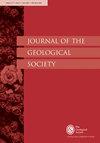Double arc–continent collision record in the Latest Mesozoic–Cenozoic tectonic history of the Himalayan–Tibetan orogenic belt in Western Pakistan
IF 3
3区 地球科学
Q2 GEOSCIENCES, MULTIDISCIPLINARY
引用次数: 1
Abstract
Our recent field investigations in western Pakistan have revealed that serpentinized peridotites here are crosscut by numerous intrusions of gabbro and tonalite. New zircon U–Pb dating of these plutons indicates Late Cretaceous–Early Eocene ages of their crystallization. They have arc-like geochemical signatures and constitute the middle crust of an island arc complex. Together with their extrusive counterparts they form the RasKoh island arc (RIA), defined for the first time in this study. The RIA and the Chaiga continental arc to the north represent the manifestations of two separate subduction zone systems within Neotethys, developed between India and Eurasia. We posit that this Neotethyan domain contained two oceanic plates. Subduction of the leading plate beneath Eurasia generated the Jurassic–Late Oligocene Chaiga continental arc, and the northward subduction of the trailing plate resulted in the development of the Late Cretaceous–Oligocene, ensimatic RasKoh arc. Arrival of the Indian subcontinent at the latitude of the RasKoh arc in the earliest Miocene caused the emplacement of the RasKoh arc onto India via oblique arc–continent collision. The subsequent collision of this composite Indian plate with Eurasia resulted in extensive deformation of Late Cretaceous flysch deposits and the ophiolitic arc basement. Thematic collection: This article is part of the Ophiolites, melanges and blueschists collection available at: https://www.lyellcollection.org/topic/collections/ophiolites-melanges-and-blueschists Supplementary material: https://doi.org/10.6084/m9.figshare.c.6795686巴基斯坦西部喜马拉雅-西藏造山带中新生代构造史上的双弧-大陆碰撞记录
我们最近在巴基斯坦西部的野外调查发现,这里的蛇纹石化橄榄岩被大量辉长岩和闪长岩侵入所横切。新的锆石U-Pb定年结果表明,这些岩体的结晶年龄为晚白垩世-早始新世。它们具有弧状地球化学特征,构成岛弧杂岩的中地壳。与它们的挤压对应物一起,它们形成了RasKoh岛弧(RIA),这是本研究中第一次定义。北侧的RIA和柴加大陆弧代表了新特提斯内部两个独立的俯冲带体系的表现,它们发育在印度和欧亚大陆之间。我们假定这个新特提斯域包含两个大洋板块。前缘板块在欧亚大陆下的俯冲作用形成了侏罗纪—晚渐新世柴加大陆弧,后缘板块的北俯冲作用形成了晚白垩世—渐新世动态拉斯科弧。中新世早期印度次大陆到达拉斯科弧纬度,导致拉斯科弧通过斜弧-大陆碰撞进入印度。这一复合印度板块随后与欧亚大陆的碰撞导致晚白垩世复理石矿床和蛇绿弧基底的广泛变形。专题收藏:本文是蛇绿岩、杂岩和蓝片岩收藏的一部分,可在:https://www.lyellcollection.org/topic/collections/ophiolites-melanges-and-blueschists补充材料:https://doi.org/10.6084/m9.figshare.c.6795686
本文章由计算机程序翻译,如有差异,请以英文原文为准。
求助全文
约1分钟内获得全文
求助全文
来源期刊

Journal of the Geological Society
地学-地球科学综合
CiteScore
6.00
自引率
3.70%
发文量
68
审稿时长
6-12 weeks
期刊介绍:
Journal of the Geological Society (JGS) is owned and published by the Geological Society of London.
JGS publishes topical, high-quality recent research across the full range of Earth Sciences. Papers are interdisciplinary in nature and emphasize the development of an understanding of fundamental geological processes. Broad interest articles that refer to regional studies, but which extend beyond their geographical context are also welcomed.
Each year JGS presents the ‘JGS Early Career Award'' for papers published in the journal, which rewards the writing of well-written, exciting papers from early career geologists.
The journal publishes research and invited review articles, discussion papers and thematic sets.
 求助内容:
求助内容: 应助结果提醒方式:
应助结果提醒方式:


